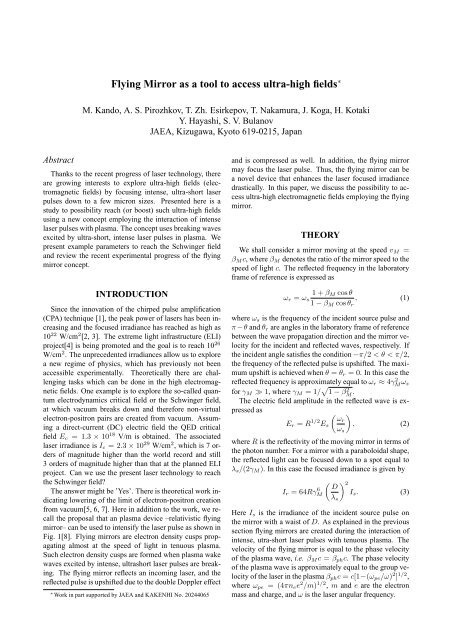Proceedings of International Conference on Physics in ... - KEK
Proceedings of International Conference on Physics in ... - KEK
Proceedings of International Conference on Physics in ... - KEK
You also want an ePaper? Increase the reach of your titles
YUMPU automatically turns print PDFs into web optimized ePapers that Google loves.
Abstract<br />
Fly<strong>in</strong>g Mirror as a tool to access ultra-high fields ∗<br />
M. Kando, A. S. Pirozhkov, T. Zh. Esirkepov, T. Nakamura, J. Koga, H. Kotaki<br />
Y. Hayashi, S. V. Bulanov<br />
JAEA, Kizugawa, Kyoto 619-0215, Japan<br />
Thanks to the recent progress <str<strong>on</strong>g>of</str<strong>on</strong>g> laser technology, there<br />
are grow<strong>in</strong>g <strong>in</strong>terests to explore ultra-high fields (electromagnetic<br />
fields) by focus<strong>in</strong>g <strong>in</strong>tense, ultra-short laser<br />
pulses down to a few micr<strong>on</strong> sizes. Presented here is a<br />
study to possibility reach (or boost) such ultra-high fields<br />
us<strong>in</strong>g a new c<strong>on</strong>cept employ<strong>in</strong>g the <strong>in</strong>teracti<strong>on</strong> <str<strong>on</strong>g>of</str<strong>on</strong>g> <strong>in</strong>tense<br />
laser pulses with plasma. The c<strong>on</strong>cept uses break<strong>in</strong>g waves<br />
excited by ultra-short, <strong>in</strong>tense laser pulses <strong>in</strong> plasma. We<br />
present example parameters to reach the Schw<strong>in</strong>ger field<br />
and review the recent experimental progress <str<strong>on</strong>g>of</str<strong>on</strong>g> the fly<strong>in</strong>g<br />
mirror c<strong>on</strong>cept.<br />
INTRODUCTION<br />
S<strong>in</strong>ce the <strong>in</strong>novati<strong>on</strong> <str<strong>on</strong>g>of</str<strong>on</strong>g> the chirped pulse amplificati<strong>on</strong><br />
(CPA) technique [1], the peak power <str<strong>on</strong>g>of</str<strong>on</strong>g> lasers has been <strong>in</strong>creas<strong>in</strong>g<br />
and the focused irradiance has reached as high as<br />
10 22 W/cm 2 [2, 3]. The extreme light <strong>in</strong>frastructure (ELI)<br />
project[4] is be<strong>in</strong>g promoted and the goal is to reach 10 26<br />
W/cm 2 . The unprecedented irradiances allow us to explore<br />
a new regime <str<strong>on</strong>g>of</str<strong>on</strong>g> physics, which has previously not been<br />
accessible experimentally. Theoretically there are challeng<strong>in</strong>g<br />
tasks which can be d<strong>on</strong>e <strong>in</strong> the high electromagnetic<br />
fields. One example is to explore the so-called quantum<br />
electrodynamics critical field or the Schw<strong>in</strong>ger field,<br />
at which vacuum breaks down and therefore n<strong>on</strong>-virtual<br />
electr<strong>on</strong>-positr<strong>on</strong> pairs are created from vacuum. Assum<strong>in</strong>g<br />
a direct-current (DC) electric field the QED critical<br />
field Ec = 1.3 × 10 18 V/m is obta<strong>in</strong>ed. The associated<br />
laser irradiance is Ic = 2.3 × 10 29 W/cm 2 , which is 7 orders<br />
<str<strong>on</strong>g>of</str<strong>on</strong>g> magnitude higher than the world record and still<br />
3 orders <str<strong>on</strong>g>of</str<strong>on</strong>g> magnitude higher than that at the planned ELI<br />
project. Can we use the present laser technology to reach<br />
the Schw<strong>in</strong>ger field?<br />
The answer might be ’Yes’. There is theoretical work <strong>in</strong>dicat<strong>in</strong>g<br />
lower<strong>in</strong>g <str<strong>on</strong>g>of</str<strong>on</strong>g> the limit <str<strong>on</strong>g>of</str<strong>on</strong>g> electr<strong>on</strong>-positr<strong>on</strong> creati<strong>on</strong><br />
from vacuum[5, 6, 7]. Here <strong>in</strong> additi<strong>on</strong> to the work, we recall<br />
the proposal that an plasma device –relativistic fly<strong>in</strong>g<br />
mirror– can be used to <strong>in</strong>tensify the laser pulse as shown <strong>in</strong><br />
Fig. 1[8]. Fly<strong>in</strong>g mirrors are electr<strong>on</strong> density cusps propagat<strong>in</strong>g<br />
almost at the speed <str<strong>on</strong>g>of</str<strong>on</strong>g> light <strong>in</strong> tenuous plasma.<br />
Such electr<strong>on</strong> density cusps are formed when plasma wake<br />
waves excited by <strong>in</strong>tense, ultrashort laser pulses are break<strong>in</strong>g.<br />
The fly<strong>in</strong>g mirror reflects an <strong>in</strong>com<strong>in</strong>g laser, and the<br />
reflected pulse is upshifted due to the double Doppler effect<br />
∗ Work <strong>in</strong> part supported by JAEA and KAKENHI No. 20244065<br />
and is compressed as well. In additi<strong>on</strong>, the fly<strong>in</strong>g mirror<br />
may focus the laser pulse. Thus, the fly<strong>in</strong>g mirror can be<br />
a novel device that enhances the laser focused irradiance<br />
drastically. In this paper, we discuss the possibility to access<br />
ultra-high electromagnetic fields employ<strong>in</strong>g the fly<strong>in</strong>g<br />
mirror.<br />
THEORY<br />
We shall c<strong>on</strong>sider a mirror mov<strong>in</strong>g at the speed vM =<br />
βMc, where βM denotes the ratio <str<strong>on</strong>g>of</str<strong>on</strong>g> the mirror speed to the<br />
speed <str<strong>on</strong>g>of</str<strong>on</strong>g> light c. The reflected frequency <strong>in</strong> the laboratory<br />
frame <str<strong>on</strong>g>of</str<strong>on</strong>g> reference is expressed as<br />
ωr = ωs<br />
1 + βM cos θ<br />
, (1)<br />
1 − βM cos θr<br />
where ωs is the frequency <str<strong>on</strong>g>of</str<strong>on</strong>g> the <strong>in</strong>cident source pulse and<br />
π −θ and θr are angles <strong>in</strong> the laboratory frame <str<strong>on</strong>g>of</str<strong>on</strong>g> reference<br />
between the wave propagati<strong>on</strong> directi<strong>on</strong> and the mirror velocity<br />
for the <strong>in</strong>cident and reflected waves, respectively. If<br />
the <strong>in</strong>cident angle satisfies the c<strong>on</strong>diti<strong>on</strong> −π/2 < θ < π/2,<br />
the frequency <str<strong>on</strong>g>of</str<strong>on</strong>g> the reflected pulse is upshifted. The maximum<br />
upshift is achieved when θ = θr = 0. In this case the<br />
reflected frequency is approximately equal to ωr ≈ 4γ 2 M ωs<br />
for γM ≫ 1, where γM = 1/ √ 1 − β 2 M .<br />
The electric field amplitude <strong>in</strong> the reflected wave is ex-<br />
pressed as<br />
Er = R 1/2 Es<br />
( ωr<br />
ωs<br />
)<br />
, (2)<br />
where R is the reflectivity <str<strong>on</strong>g>of</str<strong>on</strong>g> the mov<strong>in</strong>g mirror <strong>in</strong> terms <str<strong>on</strong>g>of</str<strong>on</strong>g><br />
the phot<strong>on</strong> number. For a mirror with a paraboloidal shape,<br />
the reflected light can be focused down to a spot equal to<br />
λs/(2γM). In this case the focused irradiance is given by<br />
Ir = 64Rγ 6 M<br />
( D<br />
λs<br />
) 2<br />
Is. (3)<br />
Here Is is the irradiance <str<strong>on</strong>g>of</str<strong>on</strong>g> the <strong>in</strong>cident source pulse <strong>on</strong><br />
the mirror with a waist <str<strong>on</strong>g>of</str<strong>on</strong>g> D. As expla<strong>in</strong>ed <strong>in</strong> the previous<br />
secti<strong>on</strong> fly<strong>in</strong>g mirrors are created dur<strong>in</strong>g the <strong>in</strong>teracti<strong>on</strong> <str<strong>on</strong>g>of</str<strong>on</strong>g><br />
<strong>in</strong>tense, utra-short laser pulses with tenuous plasma. The<br />
velocity <str<strong>on</strong>g>of</str<strong>on</strong>g> the fly<strong>in</strong>g mirror is equal to the phase velocity<br />
<str<strong>on</strong>g>of</str<strong>on</strong>g> the plasma wave, i.e. βMc = βphc. The phase velocity<br />
<str<strong>on</strong>g>of</str<strong>on</strong>g> the plasma wave is approximately equal to the group velocity<br />
<str<strong>on</strong>g>of</str<strong>on</strong>g> the laser <strong>in</strong> the plasma βphc = c[1−(ωpe/ω) 2 ] 1/2 ,<br />
where ωpe = (4πnee 2 /m) 1/2 , m and e are the electr<strong>on</strong><br />
mass and charge, and ω is the laser angular frequency.













